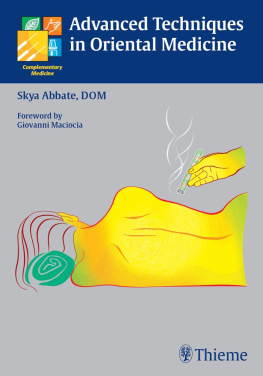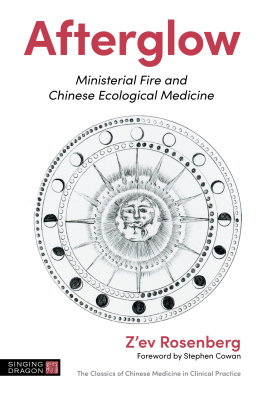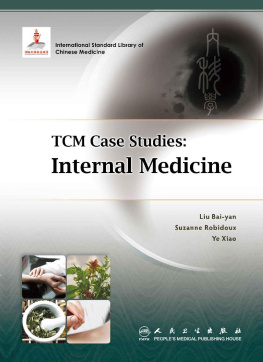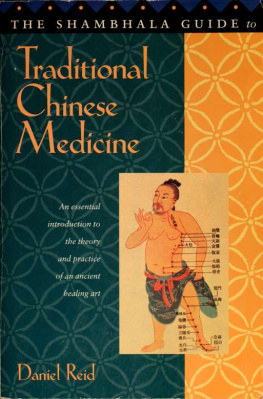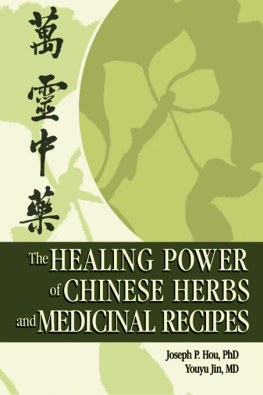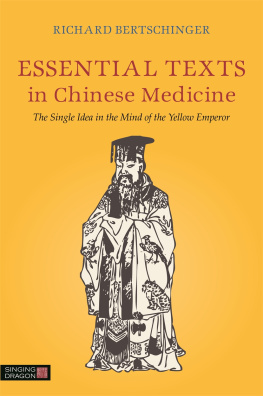Library of Congress Cataloging-in-Publication Data
Abbate, Skya.
Taming the tiger: advanced techniques
in Oriental medicine/Skya Abbate.
p.; cm.
Includes bibliographical references and index.
ISBN 3-13-143051-6 (GTV: alk. paper)
ISBN 1-58890-493-8 (TNY: alk paper)
1. Medicine, Oriental. I. Title.
[DNLM: 1. Medicine, Oriental Traditional.
2. Acupuncture Therapy. WB 50.1 A123t 2006]
610dc22 200613393
Photos by Dr. Anthony Abbate, DOM
Santa Fe, New Mexico, USA; with the exception
of Figs. 1.2, 1.2, 4.1 and 13.1 provided by Seirin Europe/
3B Scientific, Hamburg, Germany
Illustrations by Jaye Oliver, Santa Fe, New Mexico, USA
2006 Georg Thieme Verlag,
Riidigerstrasse 14, 70469 Stuttgart, Germany
http://www.thieme.de
Thieme New York, 333 Seventh Avenue,
New York, NY 10001, USA
http://www.thieme.com
Typesetting by Sommer Druck, Feuchtwangen
Printed in Germany by Grafisches Centrum Cuno, Calbe
10-ISBN 3-13-143051-6 (GTV)
13-ISBN 978-3-13-143051-9 (GTV)
10-ISBN 1-58890-493-8 (TNY)
13-ISBN 978-1-58890-493-5 (TNY) 12 3 4 5 6
Important note: Medicine is an ever-changing science undergoing continual development. Research and clinical experience are continually expanding our knowledge, in particular our knowledge of proper treatment and drug therapy. Insofar as this book mentions any dosage or application, readers may rest assured that the authors, editors, and publishers have made every effort to ensure that such references are in accordance with the state of knowledge at the time of production of the book.
Nevertheless, this does not involve, imply, or express any guarantee or responsibility on the part of the publishers in respect to any dosage instructions and forms of applications stated in the book. Every user is requested to examine carefully the manufacturers' leaflets accompanying each drug and to check, if necessary in consultation with a physician or specialist, whether the dosage schedules mentioned therein or the contraindications stated by the manufacturers differ from the statements made in the present book. Such examination is particularly important with drugs that are either rarely used or have been newly released on the market. Every dosage schedule or every form of application used is entirely at the user's own risk and responsibility. The authors and publishers request every user to report to the publishers any discrepancies or inaccuracies noticed. If errors in this work are found after publication, errata will be posted at www.thieme.com on the product description page.
Some of the product names, patents, and registered designs referred to in this book are in fact registered trademarks or proprietary names even though specific reference to this fact is not always made in the text. Therefore, the appearance of a name without designation as proprietary is not to be construed as a representation by the publisher that it is in the public domain.
This book, including all parts thereof, is legally protected by copyright. Any use, exploitation, or commercialization outside the narrow limits set by copyright legislation, without the publisher's consent, is illegal and liable to prosecution. This applies in particular to photostat reproduction, copying, mimeographing, preparation of microfilms, and electronic data processing and storage.
Dedication
Blood and qi are a human's spirit. It is not all right to not be careful in nourishing them.
Treatise of the Eight Righteous Brilliances in the Su Wen
(Simple Questions)
To all those who work in the healthcare professions, especially those who selflessly care for the sick and the poor.
To Father Vidal Martinez for always reminding me to pray for the sick.
Acknowledgement
To my husband, Anthony, for always believing in my ability to write a textbook and for giving me the leisure to devote my time to writing.
All money derived from the sale of this book will be donated to the Missionary Oblates of Mary Immaculate.
Preface
When caring for a patient, concentrate on the situation without being distracted by the circumstances, as if standing on the brink of a gorge not wanting to fall in. When you grasp the needle, do so with great care, firm strength and caution for the peril, as if holding a tiger's tail: one wrong move and great harm could befall.
Huang Di Nei Jing
Ten years ago, my first textbook, Holding the Tiger's Tail: An Acupuncture Techniques Manual in the Treatment of Disease, was published. Since then that book has been used in many acupuncture colleges both in the United States and Europe as a beginners-to-intermediate textbook for acupuncture students and practitioners. Following that book, two specialized texts were published, a Japanese treatment book, The Art of Palpatory Diagnosis in Oriental Medicine both in English and Italian (Churchill Livingstone, 2001 and 2004 respectively), and a Chinese ear acupuncture book, Chinese Auricular Acupuncture (CRC Press, 2004).
As my final needle techniques book, Advanced Techniques in Oriental Medicine, this text covers more advanced skills in Oriental medicine with an emphasis on needle technique within the context of treating common illnesses. A section on adjunct therapies for the Oriental medical practitioner is also included.
The body of knowledge of Oriental medicine is elegantly simple, and easy to understand, and to diagnose and treat with the needle and supporting modalities. Students and practitioners of Oriental medicine know the power of Oriental medicine as a diagnostic and treatment style. Most practitioners start off their practice learning all the treatment of disease (or differentiation of disease) protocols in the books available at the time of graduation, or strategies learned from experienced instructors. How we end up treating in our clinical career is a function both of our interests or specialties, as well as the disorders of the patients who come to our door. However, treatments do not need to be long, complex, employ many needles, and of course, need not be painful. As in most things in life, what are requisite to treatment are clarity, consciousness, compassion, and kindness.
I hope these simple yet effective treatment strategies will allow you to deliver effective healthcare to those in distress and to increase your satisfaction with your practice by taming the tiger, through the mastery of the needle and the tools of Oriental medicine.
Skya Abbate
2006
Foreword
When comparing acupuncture to Chinese herbal medicine, it is often said that the latter is more difficult to learn and to practice. I tend to disagree. Acupuncture is probably more difficult to learn and to practice because it involves so many variables.
To give an effective treatment, there are certain steps that are common to both acupuncture and herbal medicine, i.e.:
- a correct diagnosis (whatever system or type of Oriental medicine is used)
- a correct treatment principle
- a correct choice of treatment.
With herbal medicine, if the diagnosis and treatment principle are both correct, the prescription practically picks itself because of the close identification of treatment principle with categories of prescriptions. For example, when we say that the treatment principle is to clear heat and cool blood we mean that we need to clear heat at the blood level: this automatically corresponds to the category of cooling blood prescriptions. Similarly, when we say that we need to resolve toxic heat it means that we need to choose a formula from the category of prescriptions that resolve toxic heat.

